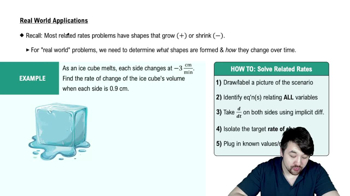Table of contents
- 0. Functions7h 52m
- Introduction to Functions16m
- Piecewise Functions10m
- Properties of Functions9m
- Common Functions1h 8m
- Transformations5m
- Combining Functions27m
- Exponent rules32m
- Exponential Functions28m
- Logarithmic Functions24m
- Properties of Logarithms34m
- Exponential & Logarithmic Equations35m
- Introduction to Trigonometric Functions38m
- Graphs of Trigonometric Functions44m
- Trigonometric Identities47m
- Inverse Trigonometric Functions48m
- 1. Limits and Continuity2h 2m
- 2. Intro to Derivatives1h 33m
- 3. Techniques of Differentiation3h 18m
- 4. Applications of Derivatives2h 38m
- 5. Graphical Applications of Derivatives6h 2m
- 6. Derivatives of Inverse, Exponential, & Logarithmic Functions2h 37m
- 7. Antiderivatives & Indefinite Integrals1h 26m
- 8. Definite Integrals4h 44m
- 9. Graphical Applications of Integrals2h 27m
- 10. Physics Applications of Integrals 2h 22m
4. Applications of Derivatives
Related Rates
Problem 3.11.31
Textbook Question
A water heater that has the shape of a right cylindrical tank with a radius of 1 ft and a height of 4 ft is being drained. How fast is water draining out of the tank (in ft³/min) if the water level is dropping at 6 min/in?
 Verified step by step guidance
Verified step by step guidance1
First, identify the shape of the tank. It is a right cylindrical tank, which means its volume can be calculated using the formula for the volume of a cylinder: \( V = \pi r^2 h \), where \( r \) is the radius and \( h \) is the height.
Given that the radius \( r \) is 1 ft and the height \( h \) is 4 ft, the volume of the tank is \( V = \pi (1)^2 h = \pi h \).
The problem states that the water level is dropping at a rate of 6 min/in. To find the rate at which the volume is changing, we need to relate the change in height to the change in volume. Use the chain rule to differentiate the volume with respect to time: \( \frac{dV}{dt} = \pi \frac{dh}{dt} \).
Convert the rate of change of the water level from min/in to ft/min. Since 1 inch is \( \frac{1}{12} \) ft, the rate \( \frac{dh}{dt} \) is \( 6 \text{ min/in} \times \frac{1}{12} \text{ ft/in} = \frac{1}{2} \text{ ft/min} \).
Substitute \( \frac{dh}{dt} = \frac{1}{2} \text{ ft/min} \) into the differentiated volume formula: \( \frac{dV}{dt} = \pi \times \frac{1}{2} \). This gives the rate at which the water is draining out of the tank in ft³/min.
 Verified video answer for a similar problem:
Verified video answer for a similar problem:This video solution was recommended by our tutors as helpful for the problem above
Video duration:
4mPlay a video:
Was this helpful?
Key Concepts
Here are the essential concepts you must grasp in order to answer the question correctly.
Volume of a Cylinder
The volume of a right circular cylinder is calculated using the formula V = πr²h, where r is the radius and h is the height. In this problem, the tank's radius is given as 1 ft, and the height is 4 ft. Understanding this formula is essential for determining how the volume of water changes as the water level drops.
Recommended video:

Example 5: Packaging Design
Related Rates
Related rates involve finding the rate at which one quantity changes in relation to another. In this scenario, we need to relate the rate of change of the water level (height) to the rate of change of the volume of water in the tank. This concept is crucial for applying calculus to solve problems involving dynamic systems.
Recommended video:

Intro To Related Rates
Differentiation
Differentiation is a fundamental concept in calculus that deals with finding the rate of change of a function. In this context, we will differentiate the volume of the cylinder with respect to time to find the rate at which water is draining from the tank. This process allows us to connect the change in height to the change in volume.
Recommended video:

Finding Differentials
Related Videos
Related Practice





